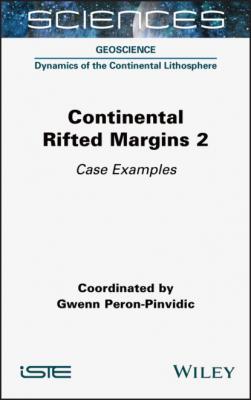Continental Rifted Margins 2. Gwenn Peron-Pinvidic
Читать онлайн.| Название | Continental Rifted Margins 2 |
|---|---|
| Автор произведения | Gwenn Peron-Pinvidic |
| Жанр | Физика |
| Серия | |
| Издательство | Физика |
| Год выпуска | 0 |
| isbn | 9781119986942 |
Figure 1.6. Summary of fault heaves analysis from the Galicia 3D volume and evolutionary model for the DGM (Lymer et al. 2019)
CONTINUATION OF CAPTION FOR FIGURE 1.6.– a) Map of the top basement level (depth shown by scale bar in meters) generated within the Galicia 3D volume (location in Figure 1.1) on which the flowlines identified from corrugations on S are used to measure heaves on the block-bounding faults. b) 3D model of fault development based on the geometry of faults within set 3/4 showing that more than one fault is needed to accommodate extension at any one time as faults have limited along strike length. The flowline heaves (c, d and e) are grouped into three sets in which the heaves are complementary: as one fault dies out the displacement is taken up on another in the same set. Overall, the cumulated heaves f) show a northward decrease in extension, consistent with the propagation of rifting from the south. g) Block diagram summarizing the model of Lymer et al. (2019) for the evolution of the DGM based on the 3D fault analysis shown in a) to f). After a period of extension and thinning, the blue faults cut across the CMB and allow the ingress of water to serpentinize the mantle. Subsequent faults propagate up through the hanging wall of preceding faults as in a rolling hinge model, but one in which the root can slip at low-angle due to serpentinization and in which multiple spatially overlapping faults are active at any one time (color coded by fault set).
In the SIAP, Legs 149 and 173 recovered synrift stratigraphy through deeper settings and thicker postrift sequence than at the DGM (Figure 1.4). Although the main focus of these legs was to characterize the basement type by specifically targeting structural highs, the SIAP drilling transect provided limited constraints on the age of some individual faults. Tilted Tithonian clays and claystones mixed with clastics and sandstones predating the faulting were recovered at Sites 1065 and 901, interpreted as having been deposited in enclosed, relatively shallow and anoxic basins, close to vegetated land (Whitmarsh et al. 1998). Benthic foraminifera recovered at Site 901 indicate a neritic zone (Collins et al. 1996), that is continental shelf environment, and were interpreted as marking the onset of the rifting (Whitmarsh and Wallace 2001). A late Berriasian–early Valanginian age for the beginning of significant extension is supported by the pre- to syn-rift nature of the sediments recovered at Site 1069 (Figure 1.4), that are constituted of shallow-water limestones, interpreted as predating the main extensional phase, overlaid by conglomerates and sandstones, interpreted as marking the onset of extension at this location (Whitmarsh et al. 1998). Later synrift units have not been sampled but the timing of crustal extension is constrained by 40Ar/39Ar cooling data for samples recovered at Site 1067 and 900, indicating that these deep crustal rocks were exhumed from >18 km (0.6Gpa) through ~4 km depth by 137 Ma (Wilson et al. 2001, pp. 429–452). Thus, in the ~10 Myr between the onset of rifting in the Tithonian and the unroofing of these rocks, the crust appears to have been thinned by a factor of ~5. The final phase of crustal extension, which produced the current observed geometry of the margin probably occurred shortly after this (Tucholke et al. 2007). In the distal zone of exhumed mantle, oceanward of Site 900 (Figures 1.1 and 1.4), a series of basement highs were drilled: the sediment atop the highs represents a minimum age for the unroofing of that particular portion of peridotitic basement. Drillings have sampled mixtures of serpentine breccias and mass flow deposits of Aptian–Barremian age that may be related to the breakup process (Tucholke et al. 2007).
To summarize, in the SIAP, the Tithonian–early Berriasian sequence is tilted and part of the pre-faulting units (Figure 1.4). The late Berriasian–early Albian sequence either onlaps previous sequences/basement, or locally thickens towards the block bounding faults. The evidence thus points towards major rifting and crustal extension occurring over perhaps 10 Myr between the Tithonian and the Valanginian, followed by a phase of mantle unroofing over a further 10 Myr, before the onset of seafloor spreading during the Aptian–Barremian. As within the DGM, extension appears to have migrated oceanwards, but culminates in the unroofing of a far wider zone of mantle rocks. Although the overall time between the onset of rifting and the spreading of seafloor is similar at the two margin segments, approximately half of that time at the SIAP only involved the unroofing and subsequent extension of mantle rocks. Hence, rift duration leading to complete crustal separation may have only been about 10 Myr. Both the DGM and SIAP exhibit tilted fault blocks, detachment faulting, tectonic CMB, serpentinization beneath hyper-extended crust, and a wide zone of mantle exposed at the seafloor during rifting. At both segments of the margin, ODP results suggest that extension during the rifting may have migrated oceanwards. However, although the WIM has been extensively studied, the details of the timing of rifting remain largely unconstrained due to the fact that most scientific drillings have targeted basement highs. This strategy, while revolutionizing our understanding of the structures of rifted margins and introducing the concept of mantle unroofing, has not recovered the complete synrift sequences needed to determine the timing of motion on individual
